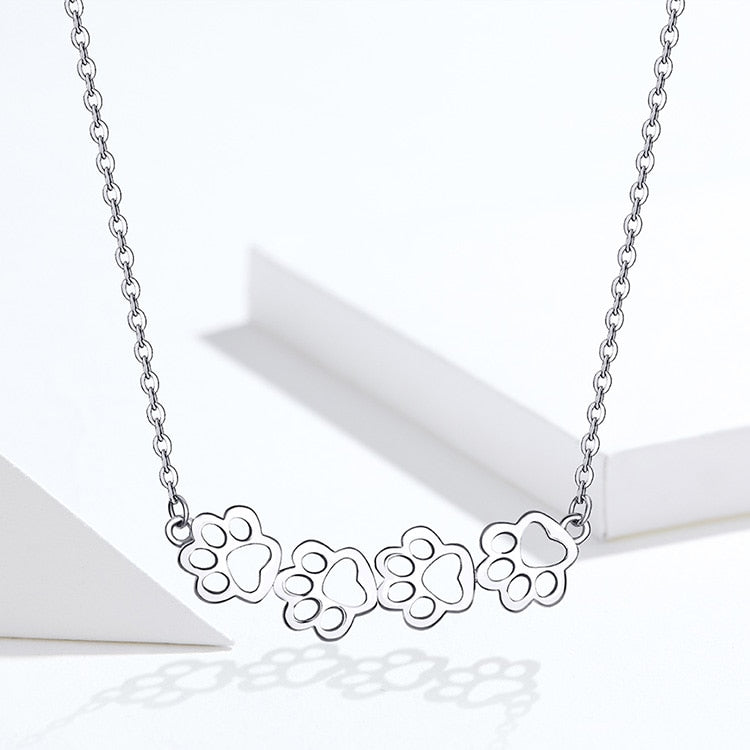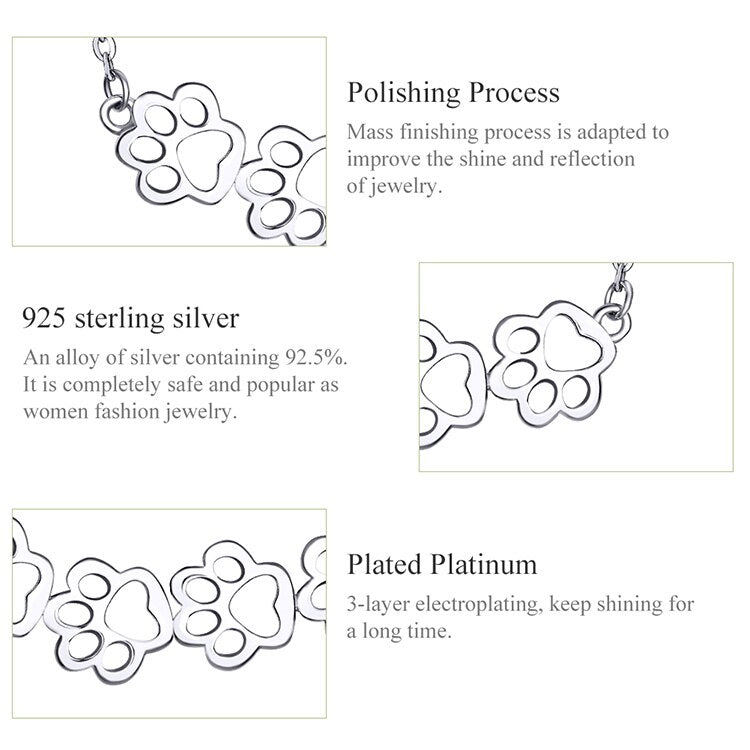EkoWorld
Pawpets Necklace in Silver 925
Pawpets Necklace in Silver 925
Couldn't load pickup availability
Free shipping
Free shipping
Returns and exchanges within 30 days
Returns and exchanges within 30 days
Returns and exchanges up to 30 days after receiving your order!
The return can be requested within 14 days of receiving the order, and made within 30 days after receiving the order.
10% discount if you add it in the 🛒
10% discount if you add it in the 🛒
Unlock an additional discount when you buy multiple items!
The more you buy, the more you save! ❤️
The more you buy, the more you save! ❤️
The more you buy, the more you save!
Buy 2 Items with 15% discount
Buy 3 Items with 20% discount
Buy 4 Items for 25% off
- Description
- Specifiche
Symbol of love and fidelity on the skin and in the heart. Dog paw earrings: anyone who still has or has had the good fortune to share their life with a four -legged friend in the past knows!
The sense of smell
The main distinctive feature of the dog is the sense of smell, derived from its prehistoric activity as a hunter. A fundamental part of his odor recognition process is the conformation of his nose (the nose) but above all the very rich internal mucosa, able to distinguish only one molecule of one substance out of millions. The nose in the dog represents the terminal end of the nose of the same. The imprint of the convolutions that distinguish it is specific to the individual and, like the fingerprints of the human being, can be used as an effective recognition system.

The most recent studies based on genetics, supported by paleontological insights, have led to the validation of the recognition of the gray wolf (Canis lupus lupus) as the ancestor of the domestic dog, recognized as a subspecies (Canis lupus familiaris). The hypotheses on the domestication process are still uncertain. One of the most accredited hypotheses is that of the spouses Ray and Lorna Coppinger, biologists, who propose the theory of a "natural domestication" of the wolf, a natural selection of subjects less skilled in hunting, but at the same time less fearful of humans, who would begin to follow the first groups of nomadic hunters, feeding on the remains of their meals, but unwittingly providing a precious "sentinel" service, later settling near the first settlements, and giving way to a surprising cohabitation between two species of predators, with mutual benefits.
Some of these "wild dogs" would later be approached and adopted into the human community (village dogs, the "pariah dogs" that are still found today in some societies, "all over the village", tolerated for their role as scavengers and of predators of small pests), giving way to a perfect example of coevolution. Almost certainly, as also demonstrated by the studies of Dimitri Belayev, the natural selection based on character attitudes to domestication has caused the appearance of physical changes (from the reduction of the skull volume, to the shortening of the teeth, but also the appearance of characters such as patches white on the coat and rolled-up tails).
The first differentiation between the various local "races" is to be attributed to the various wolf subspecies that were domesticated almost simultaneously in different parts of the world, in equally dissimilar geographic and climatic situations. We can get an idea of their appearance if we take into consideration the "modern" breeds gathered in group 5 of the FCI classification International Cynological Federation (spitz and primitive type dogs, in fact). The first dogs were certainly versatile workers, able to perform multiple tasks, from the village guard to the hunting aid, from the transport of small loads to the management of the first herds of the nascent pastoralism.
Over time, man has selected many different breeds and varieties of dogs, to help him in his many activities: therefore there are today breeds of shepherd, hunting, guard, companion, racing and others.
30 DAY MONEY BACK GUARANTEE
are you not satisfied with your purchase? You will have the option to return it and receive a full refund within 30 days of payment.
- √ COLLANA IN ARGENTO 925 STERLING AAA ALTA QUALITÀ: Le nostre collane sono realizzate in argento 925 sterling massiccio, noto per la sua resistenza, luminosità e lucentezza. L'argento Sterling delle nostre collane resiste all'ossidazione.
- Il rivestimento in rodio garantisce una lucentezza duratura e rende le collane di argento 925 resistenti all'ossidazione!
- Senza nickel, senza piombo, e senza cadmio per prevenire eventuali reazioni avverse.
- √ ADATTO AD OGNI OCCASIONE: Aggiungi stile al tuo look casual con questa collana in argento 925. Collana da indossare per chi ha una personalità unica ed emozionante. Perfetta da indossare tutti i giorni per un look che fa tendenza, a prescindere da quale sia dall'occasione. Un'aggiunta abbagliante per la tua collezione di gioielli!
- √ DESIGN MODERNO Le collane sono realizzati con un design che li rendono eleganti e trendy.
- √ UN REGALO MERAVIGLIOSO PER TUTTE LE OCCASIONI Regala a qualcuno di speciale un gioiello lussuoso e raffinato da sfoggiare con stile giorno e notte.
- √ ECCELLENTE SERVIZIO POST-VENDITA Tutti le nostre collane devono superare rigorosi test e controlli di qualità prima di essere messi in vendita. Se per qualsiasi motivo non sei completamente soddisfatto, contattaci entro 60 giorni e ti rimborseremo, senza chiedere ulteriori spiegazioni.
I gioielli EkoWorld sono progettati dai migliori designer di gioielli, sono semplici ma eleganti. Ci impegniamo a fornire gioielli unici e di alta qualità.
EkoWorld crea costantemente gioielli raffinati, concentrandosi sul perfezionare la qualità dei gioielli. Inoltre i nostri prodotti vengono sottoposti al test sanitario SGS, per la certificazione della qualità.
Materiale del prodotto:
argento Sterling 925.
Consigli per la manutenzione:
1. Evitare il contatto con sostanze acide, alcaline e corrosive.
2. Evitare l’urto con altri oggetti che potrebbero graffiarne la superficie.
3. Evitare il contatto con profumi, lozioni per il corpo, spray per capelli od ogni altro prodotto chimico che potrebbe danneggiare la lucentezza del metallo.
4. Evitare di indossare questo accessorio in caso di forte sudorazione, sotto la doccia, quando si dorme, ecc.
Nota bene:
1. Potrebbe esserci una differenza nelle misure del 2-3% a causa della misurazione manuale.
2. Le fotografie riproducono il prodotto reale; potrebbero esserci differenze di colore e aspetto a causa delle impostazioni dei diversi monitor sui quali le immagini vengono visualizzate.
Checkout safely using your preferred payment method
Discover all the jewels
-

Tree of Life
The Tree of Life commonly represents the interconnectedness of everything in the...
-

The magic of Flowers
Floriography is the 'language of flowers'. Dating back to the Victorian times...
-

World Fruit Jewels
Jewels in 925 Silver and Natural Stones inspired by the world of...
-

Animal Kingdom
The animal kingdom has been a rich source of inspiration for jewellery...

Turtle ring

Natural Stone Ring

Dragonfly earrings

Serpent Ring

Donut Charm
Popular caregories ...
View all-

Lotus flower
Lotus Flower Inspired Jewelery ...
-

Plum blossom
Jewelery inspired by the Plum Blossom
-

Sakura flowers
Sakura flower inspired jewelry ...
-

Guaranteed quality
Over 25,000 satisfied customers worldwide. -

Secure payment
We entrust the management of our online payments to Stripe and Paypal , 100% safe. -

Money Back Guarantee
Returns are possible up to 30 days from receipt of the items.

4,98 su 5 stelle
Basato su oltre 300 Recensioni.
Visualizzane una selezione o inviaci una tua foto per ottenere un Buono da 10 €































